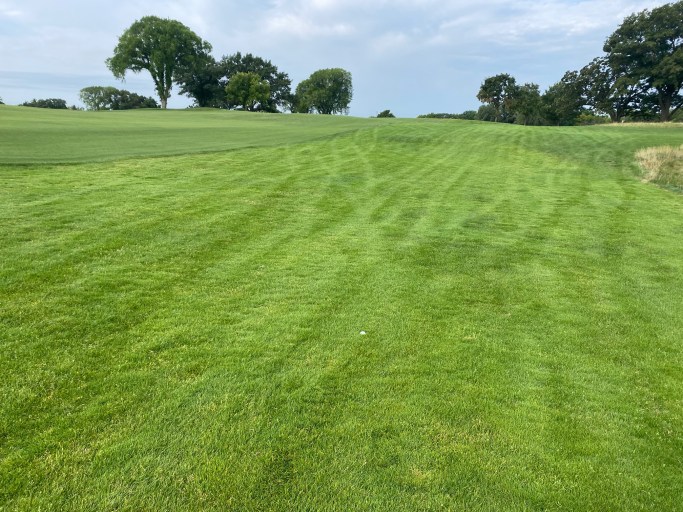A plant out of place is a weed. We commonly think of dandelions, thistle, or crabgrass, when someone talks about weeds. They are fairly easy to identify, as well as controlling, without giving much thought.
But the very definition of a weed is subjective. Sometimes those weeds are in the correct place if they’re contributing to something positive, such as erosion control on a highway road side. Sometimes they are a desirable plant, but just placed in a location where they become detrimental, such as a shrub that grows up to block your front window.
A tree planted in the wrong place can be considered a weed. That “place” could be on the East side of a green, creating morning shade, and preventing turf from performing at a high level because of that shade, and/or lack of air movement.

Or even non-native trees planted on a golf course can be considered weeds. Buckthorn, which is a non-native, invasive plant, is a relatively new weed that’s ruining landscapes all around the country. But Buckthorn growing around the perimeter of a golf course to create a wall of vegetation might not be considered a weed, because it functions in its “space” in a perceived positive way.
Poa Annua is a grass that is commonly discussed as a weed. It is the most invasive and detrimental weed to a golf course, imo. The way Poa functions itself is the exact definition of a weed. As a winter annual, meaning it produces seed as a survival mechanism, then dies off each year. That in itself is never a positive scenario when talking about a grass which dies every year by design. It’s prolific seeding ability creates many challenges to rid the grass species, as over 1 million seeds per square foot can be produced each year. That seed bank, (which seeds have viability for up to a decade) in the soil makes it one of the most impressive plants on earth, as well as difficult to control. Knowing how the plant regenerates is key. Make a ballmark on a green and don’t repair it properly? Guess what fills that void? Or take a divot in the fairway and not replace it, or fill it with divot mix? Guess what takes advantage of the sunlight on exposed soil? Poa. And the plant loves all the bad things in agronomy. Concentrated golf cart and foot traffic which creates soil compaction – Poa thrives in that environment. Areas that are over-watered, or poor draining soils with low-oxygen – Poa party. Shade from trees? 100% you’ll find Poa dominating. So why not accept it and let it thrive in those areas? Because it’s the weakest grass species on a golf course. Nothing is weaker at surviving the throes of winter, or a summer like we’ve had this year. It’s survival mechanism is to produce more seed, then die. Its very physiological mechanism is why it’s the largest liability to a golf course in our climate. Is it a fast and smooth surface to play on? Sure is, but that scenario of sustaining high performing Poa is neither sustainable nor dependable. About the only guarantee, is that it will die when you least want it to, no matter how many resources you throw at it.
So instead, we have focused on promoting Bentgrass. It’s a perennial plant that doesn’t need annual seeding to survive. It needs less water, fertility, plant protectants, and overall inputs to create a better, more consistent, surface to play the game on. During my time at Midland, I have thought about nothing more than how to strategically promote Bentgrass over Poa. We’ve reimagined our equipment fleet, altered the way our mowers physically mow the turf, created a watering, fertility, growth regulation, aerification and topdressing program to not only discourage Poa, but promote the Bentgrass. And after 13 years of being committed to this strategic program, even when it’s not always celebrated (aerification/topdressing/tree removals), it’s worked. Some years, we win the battle and promote more Bentgrass, and some years we lose that percentage battle (wet and cold years). But persistence, belief, and investing in the program has paid dividends. Yes, the Bentgrass we have on Midland’s greens, tees, and fairways isn’t a modern variety/technology, and it’s 100 year old performance and consistency isn’t comparable to new genetics, but we no longer have a majority stand of turf that brings the largest amount of liability to the club. Dead turf isn’t a business plan that anyone should be acceptable with. But remember, Mother Nature can still kill Bentgrass. It is not immune to winter-kill, or disease, or even heat stress. It’s a plant, and at the whims of extreme weather.
But what if Bentgrass grows in the wrong place? Is it a weed? Indeed it is, becaseue it doesn’t function properly if it grows in areas we don’t want it to. Bentgrass growing in the rough creates a serious playability issue, as well as a detriment to aesthetics. A plant out of place is a weed. So how does Bentgrass even get in the rough? Several ways, and depending on the situation, it dictates the amount/percentage of what constitutes the rough.
- Core aerification. For decades, all playing surfaces were core aerified. A small core of turf and soil was pulled up, drug around with a fence, then the tufts of turf were blown into the rough. Some of those cores were still viable, and established on bunker faces, green, tee, and fairway surrounds.

- Downpours. A Bentgrass seed is about 1 millimeter in length and virtually weighs nothing. When we receive downpour rain events, that seed can/will float and be deposited on slopes and low areas of rough. Think about the tilt of certain fairways like #2 and 9, and in a washout rain, almost every divot that is not rooted on the entire fairway, will end up washed to the low area of the rough, where it germinates and establishes. Even tee boxes after a downpour, will have all of its divots washed away and deposited in the rough, as tees are not completely flat, but tipped ever so slightly to get proper surface drainage. Think about how many divots are on #4 and 7 tee boxes. Every single fresh divot can wash away in a thunderstorm, and have several times just this season.

- Growing characteristics. Bentgrass, or also known as Creeping Bentgrass, grows laterally via stolons. That lateral growth naturally creeps from the edge of a green, tee, or fairway, into the rough.
So why is Bentgrass considered a weed growing in the rough? Bentgrass is a beautiful surface when mown at low heights. Again, the way it grows above ground, via stolons is not very noticeable at heights of cut under 1/2″. But left to grow to 2.5″, its growth characteristics creates a terrible playing surface. If you can first find your ball in Bentgrass rough, you’re left with turf that is so full of stolons that it’s difficult to even advance the ball. It has the playability of Bermuda rough, which if you’ve played out of, is not enjoyable, and borders on being too difficult. Couple that with just missing the fairway, and finding Bentgrass rough, the punishment doesn’t always fit the crime.


Then there’s the aesthetics of established Bentgrass in the rough. A large part of our Master Plan project was to promote the beautiful land with Seth Raynor architecture, via grassing line presentation. Meaning, we don’t stripe our fairways, or rough, we no longer have an “intermediate rough,” all which take away from promoting the visual aesthetic of the land, as well as the landing zone. The grassing lines (or edge of the fairways) are linear in a classic Seth Raynor presentation. But when the same grass variety of the fairway is the same as the rough, that presentation is muted, and takes away from the definition. Then there is the disease aspect of Bentgrass growing in the rough. Again, because of its growing characteristics, all of those stolons creating a thick mat at 2.5″ is a perfect scenario for disease because of extended leaf wetness. We don’t treat our rough preventively or curatively for turf diseases, so diseased Bentgrass in the rough can look unsightly.

So what can we do about removing Bentgrass from the rough? We can selectively remove it, using a chemistry (Mesotrione) that will leave the desirable turf species, and remove the undesirables (Bentgrass and Poa), as well as other broadleaf weeds. This chemistry has been proven to be safe and effective. However, the way the technology works is by removing the chlorophyll in the undesirables, making them completely white. This can be surprising the first time you see it. However, you are able to re-seed into those areas safely and quickly establish new grasses.
Below you can see Bentgrass that was treated in the upper part of the picture, and below a check plot was created

The next 2 pictures below show Bentgrass after being treated with Mesotrione


We will be completing a test plot of ~1 acre of rough this Fall. The areas we’ve decided to do are based on learning how much actual Bentgrass is in the rough in areas that; we know we have it, as well as to remediate areas that are almost all Bentgrass, as to give you perspective on what playability improvements would take place. The process will take about 4 weeks to complete, and we’ll have new grass growing in those areas by October.
The two areas will be to the right of 14 Fairway, to the right of 17 Fairway, as well as Tee, Green Surround/Bunkers on hole 5. We need to learn how to best re-seed/establish these areas with the tools we have, so getting a sample of several areas/scenarios/landforms is important for information gathering. After completing these test areas this year, the Greens Committee will then decide if a recommendation to the BOD is desirable to do a future larger scale project.

I will communicate to the membership once the project starts, as well as along the way, to inform everyone of the process. Thanks for supporting our department in the continual pursuit to make Midland the best possible golf experience possible.
Mike Manthey


Thanks for another great update and another informative Turf grass blog. I always learn so much from what you write. As you probably know, many of us enjoy discussing what you and your team are accomplishing as we chat while looking for our continual seemingly never-ending wayward shots.
PK, appreciate you! Worth the time to write when it leads to you enjoying your continual walks a little more!
M.
Very educational and appreciate better-understanding the logic and process.
Thanks Terry.
M.